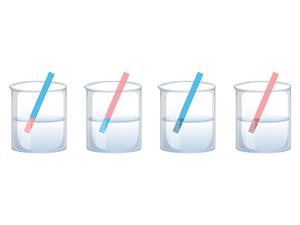
PUMPA - SMART LEARNING
எங்கள் ஆசிரியர்களுடன் 1-ஆன்-1 ஆலோசனை நேரத்தைப் பெறுங்கள். டாப்பர் ஆவதற்கு நாங்கள் பயிற்சி அளிப்போம்
Book Free DemoLet us start with a small activity to test acid, base and neutral solution.
You have been given three test tubes. One contains distilled water, while the other two contain acidic and basic solutions, respectively. How will you identify the contents of each test tube if you only have red litmus paper?

Effect of litmus paper in different types of solution
Red litmus paper has no effect in acid solution. If it changes to blue, then we call the solution a base. If the colour changes to purple, then we call it a neutral solution.
Activity 1:
Collect the samples listed below from the science laboratory, observe the colour change with the help of the indicators provided, and tabulate the results.
Samples:
- Hydrochloric acid HCl
- Sulphuric acid H_2SO_4
- Nitric acid HNO_3
- Acetic acid CH_3COOH
- Sodium hydroxide NaOH
- Calcium hydroxide {Ca(OH)_2}
- Potassium hydroxide KOH
- Magnesium hydroxide {Mg(OH)_2}
- Ammonium hydroxide NH_4OH
Indicators:
- Red litmus
- Blue litmus
- Phenolphthalein
- Methyl orange
Note:
Phenolphthalein solution is colourless, whereas methyl orange solution is orange in colour.
To be remember that acids and bases react differently with these indicators.
Sample solution | Red litmus | Blue litmus | Phenolphthalein | Methyl orange |
Acids | No change | Changes to red colour | Colourless | Red |
Bases | Changes to blue colour | No change | Pink | Yellow |
Therefore, from the given samples, we can now predict the changes with the help of the above table. The change in colour of these indicators tells us whether a substance is acidic or basic in nature.
Sample solution | Red litmus | Blue litmus | Phenolphthalein | Methyl orange |
Hydrochloric acid HCl | No change | Changes to red colour | Colourless | Red |
Sulphuric acid H_2SO_4 | No change | Changes to red colour | Colourless | Red |
Nitric acid HNO_3 | No change | Changes to red colour | Colourless | Red |
Acetic acid CH_3COOH | No change | Changes to red colour | Colourless | Red |
Calcium hydroxide {Ca(OH)_2} | Changes to blue colour | No change | Pink | Yellow |
Potassium hydroxide KOH | Changes to blue colour | No change | Pink | Yellow |
Magnesium hydroxide {Mg(OH)_2} | Changes to blue colour | No change | Pink | Yellow |
Ammonium hydroxide NH_4OH | Changes to blue colour | No change | Pink | Yellow |
Some substances' odours change when exposed to acidic or basic media. These are called olfactory indicators.
Let us put some of these indicators to the test.
Activity 2:
Olfactory indicators:
- Onion
- Vanilla essence
- Clove oil
Step 1: Place some finely chopped onions in a plastic bag with some clean cloth strips.
Step 2: Tie the bag tightly and place it in the fridge overnight.
Step 3: Acids and bases can now be tested using cloth strips.
Examine the odour of these cloth strips. Place them on a clean surface and add a few drops of dilute HCl solution to one of the cloth strips and dilute NaOH solution on the other.
Observation:
Sample | Acid HCl solution | Base NaOH solution |
Onion | Retains the odour | Odourless |
Vanilla essence | Retains the odour | Odourless |
Clove oil | Retains the odour | Odourless |
Result: All the above olfactory indicators do not lose their odour in an acidic medium, but they lose their odour in a basic medium.
So now we can find whether the given substance is acid or base based on the indicators. In activity 1, we found the changes visually, whereas, in activity 2, we found the changes with the help of smell.
So now we can find whether the given substance is acid or base based on the indicators. In activity 1, we found the changes visually, whereas, in activity 2, we found the changes with the help of smell.